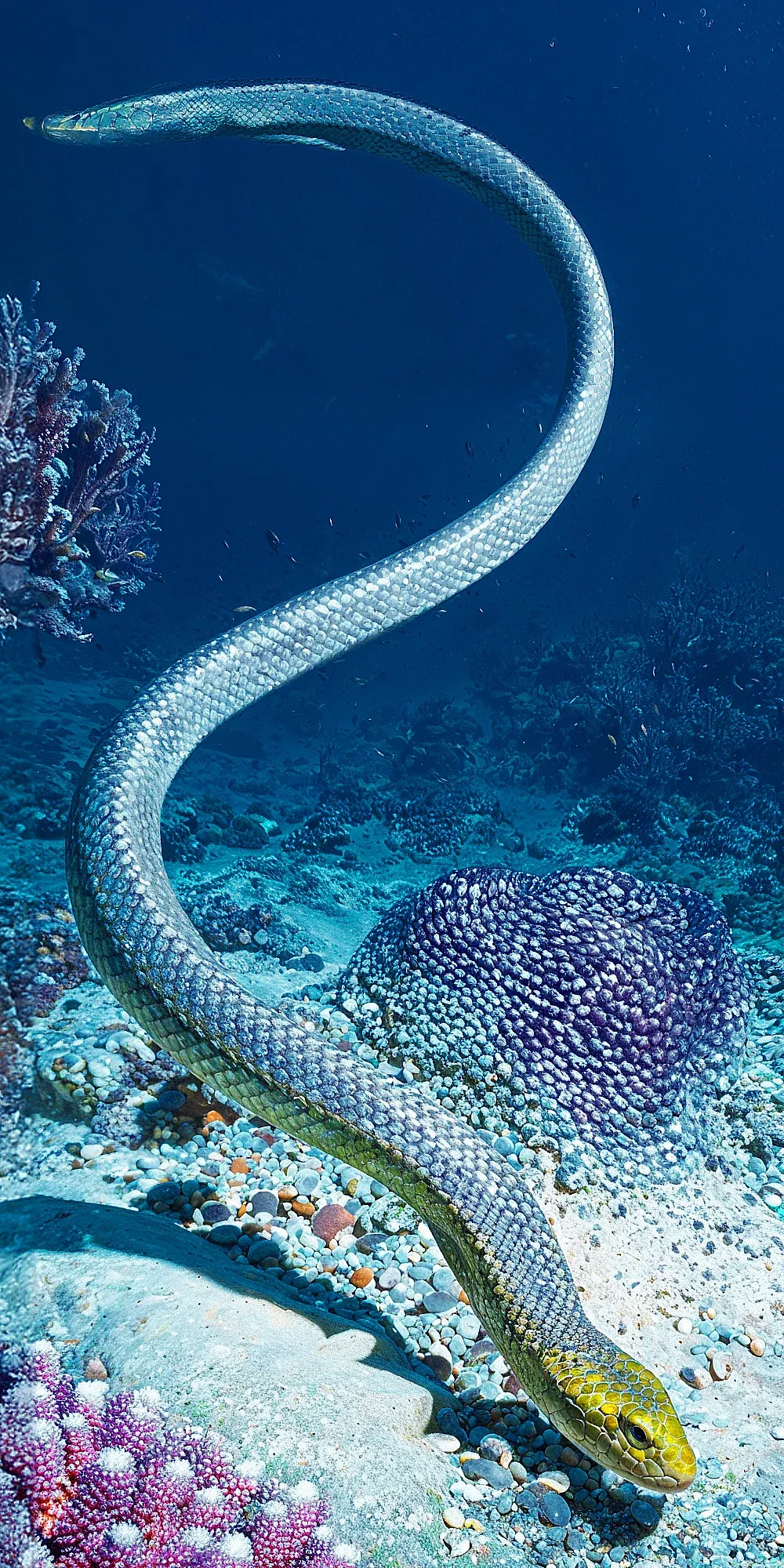The Olive Sea Snake
The Olive Sea Snake, also known as the Aipysurus laevis, is a highly venomous species found in the waters of the Indo-Pacific region. They have a distinctive olive-green coloration with a paler belly and can grow up to 6 feet in length. These snakes have paddle-like tails, allowing them to swim gracefully through the water. Olive Sea Snakes are air-breathing reptiles but can spend significant amounts of time underwater, surfacing occasionally to breathe.

| Olive Sea Snake | |
|---|---|
| Size | Up to 6 feet (1.8 meters) |
| Weight | Up to 4.4 pounds (2 kilograms) |
| Speed | 5-7 mph (8-11 km/h) |
| Key Strength | Venomous bite |
| Biggest Weakness | Slowness on land |
| Scientific Name | Aipysurus laevis |
| Family | Elapidae |
| Habitat | Coral reefs, rocky shores |
| Geography | Indian and Pacific Oceans |
| Diet | Fish, eels |
| Lifespan | 7 years - 10 years |

The Olive Sea Snake
The Olive Sea Snake, also known as the Aipysurus laevis, is a highly venomous species found in the waters of the Indo-Pacific region. They have a distinctive olive-green coloration with a paler belly and can grow up to 6 feet in length. These snakes have paddle-like tails, allowing them to swim gracefully through the water. Olive Sea Snakes are air-breathing reptiles but can spend significant amounts of time underwater, surfacing occasionally to breathe.
Fun Fact: Olive Sea Snakes are known for their unique ability to spend extended periods of time in saltwater without needing to come ashore for freshwater, unlike many other sea snakes.
| Olive Sea Snake | |
|---|---|
| Size | Up to 6 feet (1.8 meters) |
| Weight | Up to 4.4 pounds (2 kilograms) |
| Speed | 5-7 mph (8-11 km/h) |
| Key Strength | Venomous bite |
| Biggest Weakness | Slowness on land |
| Scientific Name | Aipysurus laevis |
| Family | Elapidae |
| Habitat | Coral reefs, rocky shores |
| Geography | Indian and Pacific Oceans |
| Diet | Fish, eels |
| Lifespan | 7 years - 10 years |
Olive Sea Snake Matchups
We use AI to simulate matchups between the Olive Sea Snake and other animals. Our simulation considers size, strength, and natural predatory behaviors to determine the most likely outcome.
Olive Sea Snake: Diet, Predators, Aggression, and Defensive Behaviors
What do Olive Sea Snakes eat?
Olive Sea Snakes primarily feed on small fish, such as eels, gobies, and other reef-dwelling species. They are known to be highly skilled hunters, using their excellent eyesight and powerful venom to catch and subdue their prey.
Do Olive Sea Snakes have any predators?
As adults, Olive Sea Snakes have very few natural predators due to their venomous nature. However, they may still fall victim to sharks, large predatory fish, and sea eagles when they are young or during mating season.
Are Olive Sea Snakes aggressive?
Olive Sea Snakes are generally not aggressive towards humans unless they feel threatened or cornered. They would rather flee than engage in conflict, but they can become defensive and may bite if provoked.
Do Olive Sea Snakes fight?
While Olive Sea Snakes do not engage in fights for territory or mating rights, they may fight with each other if they feel threatened or during disputes over food. These fights typically involve biting and coiling around each other.
How do Olive Sea Snakes defend themselves?
Olive Sea Snakes mainly defend themselves by relying on their potent venom. Their venom is highly toxic and can quickly incapacitate or kill their predators. They also have a flattened, paddle-like tail that helps them swim swiftly to escape danger.
What is the biggest weakness of Olive Sea Snakes in a fight?
Despite their powerful venom and agility in the water, Olive Sea Snakes have a vulnerability on land. Due to their specialized adaptations for swimming, they are much slower and less coordinated on land, making them easier targets for predators when stranded ashore.
Fun Fact: Despite their potent venom, Olive Sea Snakes are docile creatures and rarely pose a threat to humans unless provoked.
Fun Fact: Olive Sea Snakes have specialized glands near their eyes that allow them to excrete excess salt from their bodies, making them well-adapted to their oceanic habitat.










